Effect of Lightweight Aggregate Impregnation on Selected Concrete Properties
Abstract
:1. Introduction
2. Materials and Methods
3. Results
3.1. Results of Density Measurements
3.2. Water Absorption Results
3.3. Compressive Strength Results
4. Discussion
4.1. Density and Its Changes during Drying
4.2. Water Absorption
4.3. Compressive Strength
5. Conclusions
- The most crucial factors determining the effectiveness of impregnation of lightweight aggregates with cement pastes in modifying the properties of concrete composites were the aggregate type (its porosity structure) and its size. Other parameters, such as the composition of impregnating slurry and the initial moisture content of LWA before pre-coating, also mattered.
- Selecting pre-coated aggregates with cement paste resulted in relatively slight increase in concrete density (by up to 19%), on the one hand. On the other hand, it caused a very significant reduction (by up to 52%) in composite water absorption and an incomparably greater (by up to 107%) growth in compressive strength. Due to an overly large size and the high porosity of particles of Leca 8/16 mm, concretes with this pre-coated aggregates turned out to be the only exceptions, where impregnation did not affect such a pronounced increase in strength (only up to 19%).
- Contrary to expectations, the lower water-cement ratio of the slurry used for pre-coating lightweight aggregates was not conducive to increasing the efficiency of LWA impregnation in improving the properties of concrete composites. The probable explanation of this phenomenon is a special mechanism of cement paste absorption by the porous aggregate.
- Application of lightweight aggregates in moistened condition for pre-coating treatment significantly reduced the effectiveness of impregnation in the modification of the properties of LWACs. The water absorption decrease was reduced up to 39%, while the strength increase was limited to 32%.
- Due to the specificity of tests, except density, there is no direct quantitative relationship between the properties of LWAs pre-coated with cement paste and the properties of concrete composites made of these aggregates.
Author Contributions
Funding
Institutional Review Board Statement
Informed Consent Statement
Data Availability Statement
Acknowledgments
Conflicts of Interest
References
- Chandra, S.; Berntsson, L. Lightweight Aggregate Concrete: Science, Technology and Applications, 1st ed.; William Andrew: Norwich, NY, USA, 2002. [Google Scholar]
- Clarke, J. Structural Lightweight Aggregate Concrete; Chapman & Hall: Glasgow, UK, 1993. [Google Scholar]
- Neville, A.M. Properties of Concrete, 5th ed.; Pearson Education Limited: London, UK, 2012. [Google Scholar]
- Solak, A.M.; Tenza-Abril, A.J.; García-Vera, V.E. Influence of the Segregation Phenomenon on Structural Efficiency of Lightweight Aggregate Concretes. Materials 2020, 13, 5754. [Google Scholar] [CrossRef] [PubMed]
- Tang, P.; Brouwers, H.J.H. The Durability and Environmental Properties of Self-Compacting Concrete Incorporating Cold Bonded Lightweight Aggregates Produced from Combined Industrial Solid Wastes. Constr. Build. Mater. 2018, 167, 271–285. [Google Scholar] [CrossRef]
- Fujiki, E.; Kokubu, K.; Hosaka, T. Freezing and Thawing Resistance of Lightweight Aggregate Concrete. In Proceedings of the IV CANMET/ACI/JCI International Conference, Tokushima, Japan, 1 January 1998; pp. 791–814. [Google Scholar]
- Lotfy, A.; Hossain, K.M.A.; Lachemi, M. Durability Properties of Lightweight Self-Consolidating Concrete Developed with Three Types of Aggregates. Constr. Build. Mater. 2016, 106, 43–54. [Google Scholar] [CrossRef]
- Bogas, J.A.; Real, S. A Review on the Carbonation and Chloride Penetration Resistance of Structural Lightweight Aggregate Concrete. Materials 2019, 12, 3456. [Google Scholar] [CrossRef] [Green Version]
- Domagała, L. Durability of Structural Lightweight Concrete with Sintered Fly Ash Aggregate. Materials 2020, 13, 4565. [Google Scholar] [CrossRef] [PubMed]
- Domagała, L. The Effect of Lightweight Aggregate Water Absorption on the Reduction of Water-Cement Ratio in Fresh Concrete. In Procedia Engineering; Elsevier Ltd.: Cracow, Poland, 2015; Volume 108, pp. 206–213. [Google Scholar] [CrossRef] [Green Version]
- EN 206:2013+A1:2016; FprA2—Concrete—Specification, Performance, Production and Conformity. European Committee for Standardization: Brussels, Belgium, 2020.
- Sukontasukkul, P.; Sangpet, T.; Newlands, M.; Yoo, D.Y.; Tangchirapat, W.; Limkatanyu, S.; Chindaprasirt, P. Thermal Storage Properties of Lightweight Concrete Incorporating Phase Change Materials with Different Fusion Points in Hybrid Form for High Temperature Applications. Heliyon 2020, 6, e04863. [Google Scholar] [CrossRef]
- Wu, F.; Yu, Q.; Liu, C.; Brouwers, H.J.H.; Wang, L. Effect of Surface Treatment of Apricot Shell on the Performance of Lightweight Bio-Concrete. Constr. Build. Mater. 2019, 229, 116859. [Google Scholar] [CrossRef]
- Uthaichotirat, P.; Sukontasukkul, P.; Jitsangiam, P.; Suksiripattanapong, C.; Sata, V.; Chindaprasirt, P. Thermal and Sound Properties of Concrete Mixed with High Porous Aggregates from Manufacturing Waste Impregnated with Phase Change Material. J. Build. Eng. 2020, 29, 101111. [Google Scholar] [CrossRef]
- Ismail, S.; Ramli, M. Mechanical Strength and Drying Shrinkage Properties of Concrete Containing Treated Coarse Recycled Concrete Aggregates. Constr. Build. Mater. 2014, 68, 726–739. [Google Scholar] [CrossRef]
- Akyuncu, V.; Sanliturk, F. Investigation of Physical and Mechanical Properties of Mortars Produced by Polymer Coated Perlite Aggregate. J. Build. Eng. 2021, 38, 102182. [Google Scholar] [CrossRef]
- Bideci, A.; Gültekin, A.H.; Yildirim, H.; Oymael, S.; Bideci, Ö.S. Internal Structure Examination of Lightweight Concrete Produced with Polymer-Coated Pumice Aggregate. Compos. Part B Eng. 2013, 54, 439–447. [Google Scholar] [CrossRef]
- Alghamri, R.; Kanellopoulos, A.; Al-Tabbaa, A. Impregnation and Encapsulation of Lightweight Aggregates for Self-Healing Concrete. Constr. Build. Mater. 2016, 124, 910–921. [Google Scholar] [CrossRef]
- Felekolu, B. A Method for Improving the Early Strength of Pumice Concrete Blocks by Using Alkyl Alkoxy Silane (AAS). Constr. Build. Mater. 2012, 28, 305–310. [Google Scholar] [CrossRef]
- SallI Bideci, Ö. The Effect of High Temperature on Lightweight Concretes Produced with Colemanite Coated Pumice Aggregates. Constr. Build. Mater. 2016, 113, 631–640. [Google Scholar] [CrossRef]
- Kareem, A.I.; Nikraz, H.; Asadi, H. Performance of Hot-Mix Asphalt Produced with Double Coated Recycled Concrete Aggregates. Constr. Build. Mater. 2019, 205, 425–433. [Google Scholar] [CrossRef]
- Bideci, S.Ö.; Bideci, A.; Gültekin, A.H.; Oymael, S.; Yildirim, H. Polymer Coated Pumice Aggregates and Their Properties. Compos. Part B Eng. 2014, 67, 239–243. [Google Scholar] [CrossRef]
- Nozahic, V.; Amziane, S. Influence of Sunflower Aggregates Surface Treatments on Physical Properties and Adhesion with a Mineral Binder. Compos. Part A Appl. Sci. Manuf. 2012, 43, 1837–1849. [Google Scholar] [CrossRef]
- Kulkarni, P.; Muthadhi, A. Improving Thermal and Mechanical Property of Lightweight Concrete Using N-Butyl Stearate/Expanded Clay Aggregate with Alccofine1203. Int. J. Eng. Trans. A Basics 2020, 33, 1842–1851. [Google Scholar] [CrossRef]
- Al-Mohamadawi, A.; Benhabib, K.; Dheilly, R.M.; Goullieux, A. Influence of Lignocellulosic Aggregate Coating with Paraffin Wax on Flax Shive and Cement-Shive Composite Properties. Constr. Build. Mater. 2016, 102, 94–104. [Google Scholar] [CrossRef]
- Li, W.; Ling, C.; Jiang, Z.; Yu, Q.Q. Evaluation of the Potential Use of Form-Stable Phase Change Materials to Improve the Freeze-Thaw Resistance of Concrete. Constr. Build. Mater. 2019, 203, 621–632. [Google Scholar] [CrossRef]
- Wang, X.F.; Yang, Z.H.; Fang, C.; Wang, W.; Liu, J.; Xing, F. Effect of Carbonate-Containing Self-Healing System on Properties of a Cementitious Composite: Fresh, Mechanical, and Durability Properties. Constr. Build. Mater. 2020, 235, 117442. [Google Scholar] [CrossRef]
- Alazhari, M.; Sharma, T.; Heath, A.; Cooper, R.; Paine, K. Application of Expanded Perlite Encapsulated Bacteria and Growth Media for Self-Healing Concrete. Constr. Build. Mater. 2018, 160, 610–619. [Google Scholar] [CrossRef]
- Zhao, Z.; Wang, S.; Lu, L.; Gong, C. Evaluation of Pre-Coated Recycled Aggregate for Concrete and Mortar. Constr. Build. Mater. 2013, 43, 191–196. [Google Scholar] [CrossRef]
- Mistri, A.; Dhami, N.; Bhattacharyya, S.K.; Barai, S.V.; Mukherjee, A.; Biswas, W.K. Environmental Implications of the Use of Bio-Cement Treated Recycled Aggregate in Concrete. Resour. Conserv. Recycl. 2021, 167, 105436. [Google Scholar] [CrossRef]
- Yang, L.; Kou, S.; Song, X.; Lu, M.; Wang, Q. Analysis of Properties of Pervious Concrete Prepared with Difference Paste-Coated Recycled Aggregate. Constr. Build. Mater. 2021, 269, 121244. [Google Scholar] [CrossRef]
- Domagała, L.; Bryła, E. The Properties of Lightweight Aggregates Pre-Coated with Cement Pastes and Their Suitability for Concrete. Materials 2021, 14, 6417. [Google Scholar] [CrossRef] [PubMed]
- Sasanipour, H.; Aslani, F. Durability Assessment of Concrete Containing Surface Pretreated Coarse Recycled Concrete Aggregates. Constr. Build. Mater. 2020, 264, 120203. [Google Scholar] [CrossRef]
- Li, J.; Xiao, H.; Zhou, Y. Influence of Coating Recycled Aggregate Surface with Pozzolanic Powder on Properties of Recycled Aggregate Concrete. Constr. Build. Mater. 2009, 23, 1287–1291. [Google Scholar] [CrossRef]
- Sicakova, A.; Urban, K. The Influence of Discharge Time, Kind of Additive, and Kind of Aggregate on the Properties of Three-Stage Mixed Concrete. Sustainability 2018, 10, 3862. [Google Scholar] [CrossRef] [Green Version]
- EN 1097-3:1998; Tests for Mechanical and Physical Properties of Aggregates-Part 3: Determination of Loose Bulk Density and Voids. European Committee for Standardization: Brussels, Belgium, 1998.
- EN 13055:2016; Lightweight Aggregates. European Committee for Standardization: Brussels, Belgium, 2016.
- EN 12350-5:2019; Testing Fresh Concrete-Part 5: Flow Table Test. European Committee for Standardization: Brussels, Belgium, 2019.
- EN 12390-2:2019; Testing Hardened Concrete-Part 2: Making and Curing Specimens for Strength Tests. European Committee for Standardization: Brussels, Belgium, 2019.
- EN 12390-3:2019; Testing Hardened Concrete-Part 3: Compressive Strength of Test Specimens. European Committee for Standardization: Brussels, Belgium, 2009.
- EN 12390-7:2009; Testing Hardened Concrete-Part 7: Density of Hardened Concrete. European Committee for Standardization: Brussels, Belgium, 2009.
- EN 1992-1-1; Eurocode 2: Design of Concrete Structures—Part 1-1: General Rules and Rules for Buildings. European Committee for Standardization: Brussels, Belgium, 2004.
- PN-88/B-06250; Beton Zwykły. Polski Komitet Normalizacyjny: Warsaw, Poland, 1988.
- Domagała, L. The Influence of Porous Aggregate on Microstructure of the Interfacial Transition Zone in Lightweight Concrete. Cem. Wapno Beton 2011, 111–114. Available online: https://www.researchgate.net/publication/286826183_The_influence_of_porous_aggregate_on_microstructure_of_the_interfacial_transition_zone_in_lightweight_concrete (accessed on 23 December 2021).
- Zhang, M.H.; Gjørv, O.E. Penetration of Cement Paste into Lightweight Aggregate. Cem. Concr. Res. 1992, 22, 47–55. [Google Scholar] [CrossRef]
- PN-91/B-06250; Beton Lekki Kruszywowy. Polski Komitet Normalizacyjny: Warsaw, Poland, 1991.

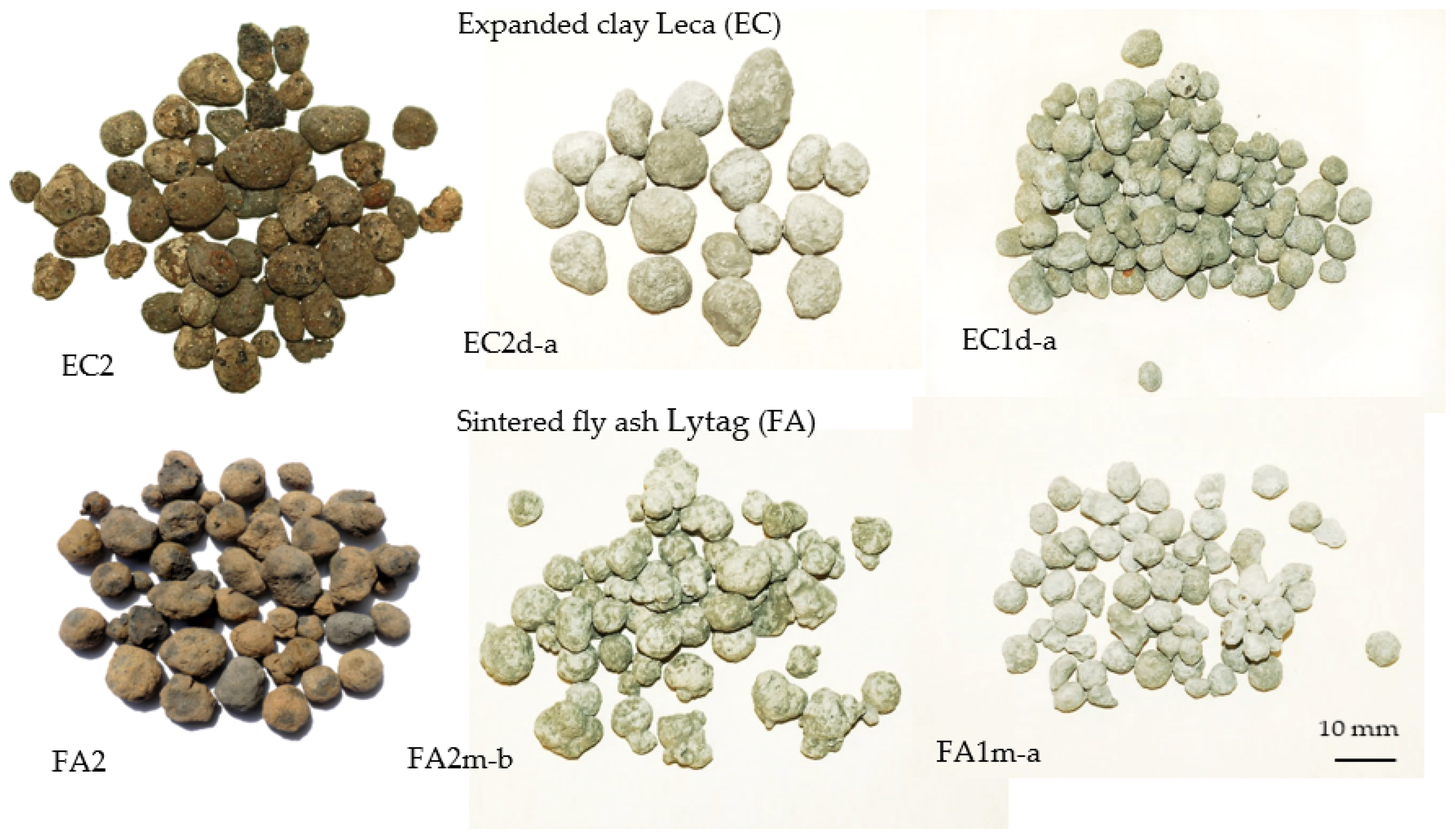
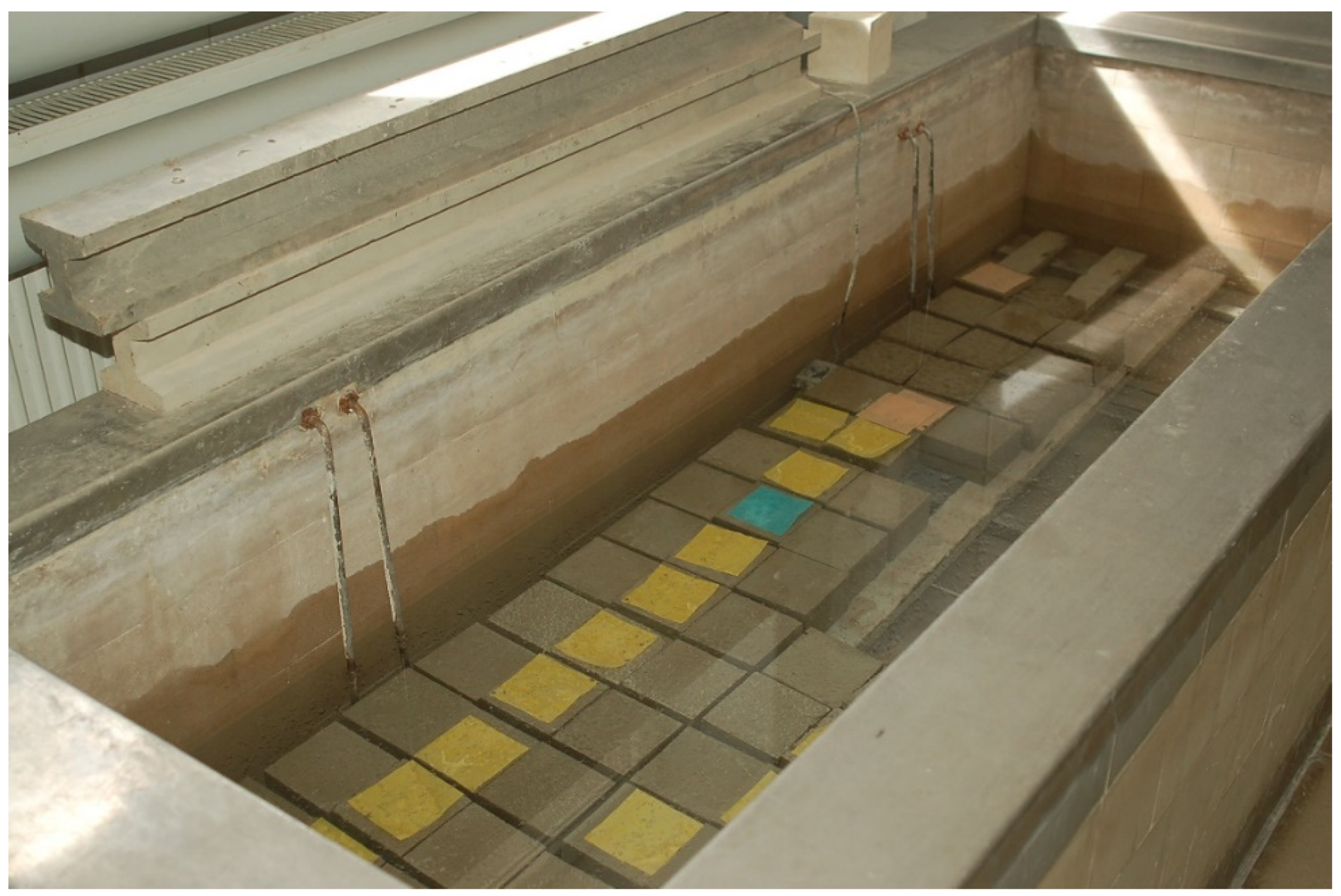

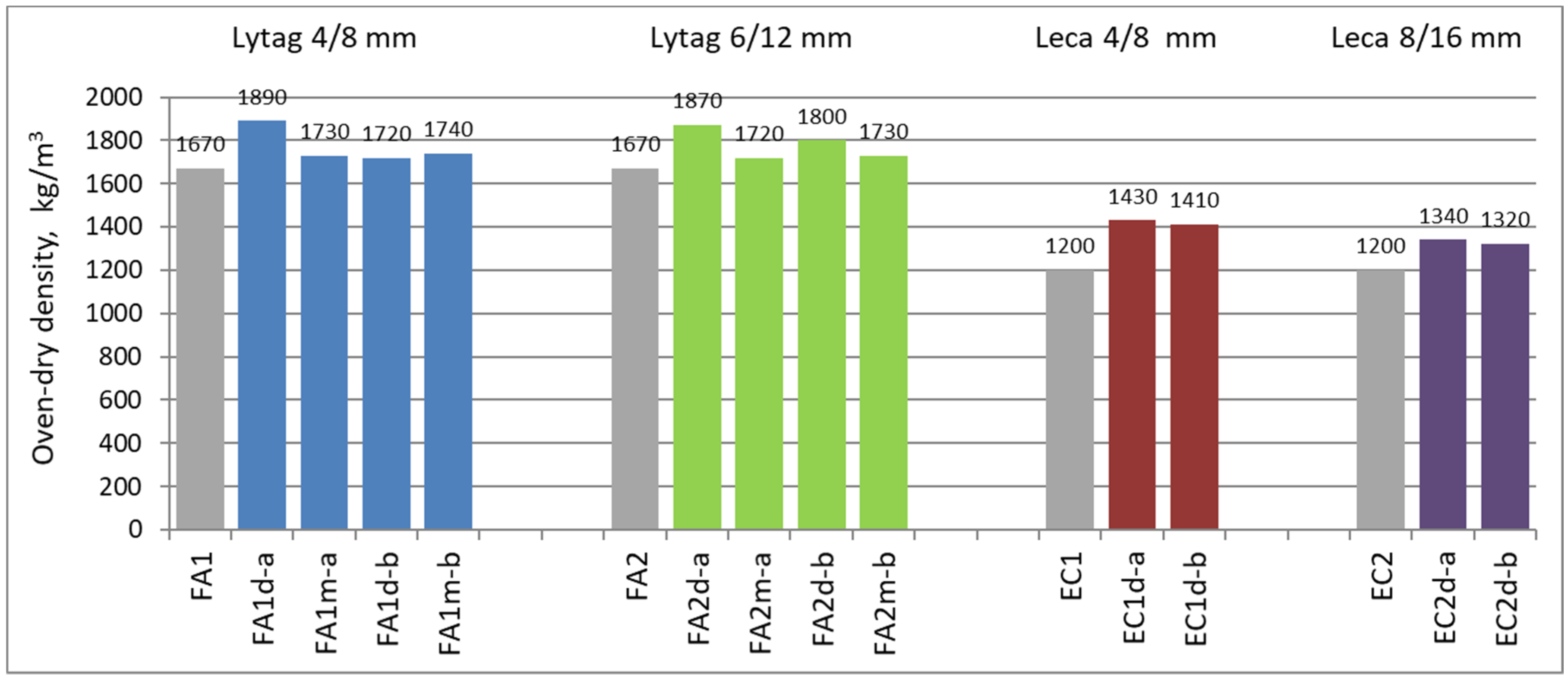
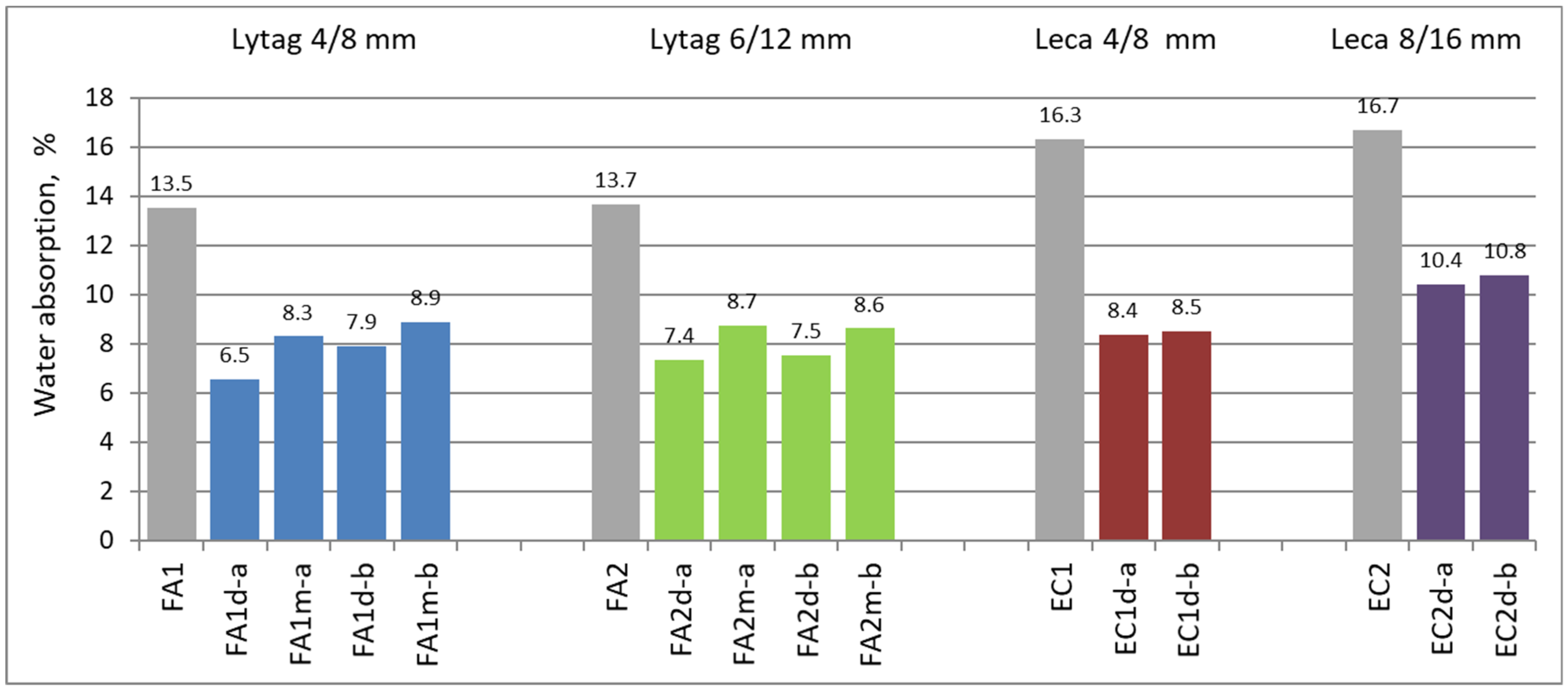
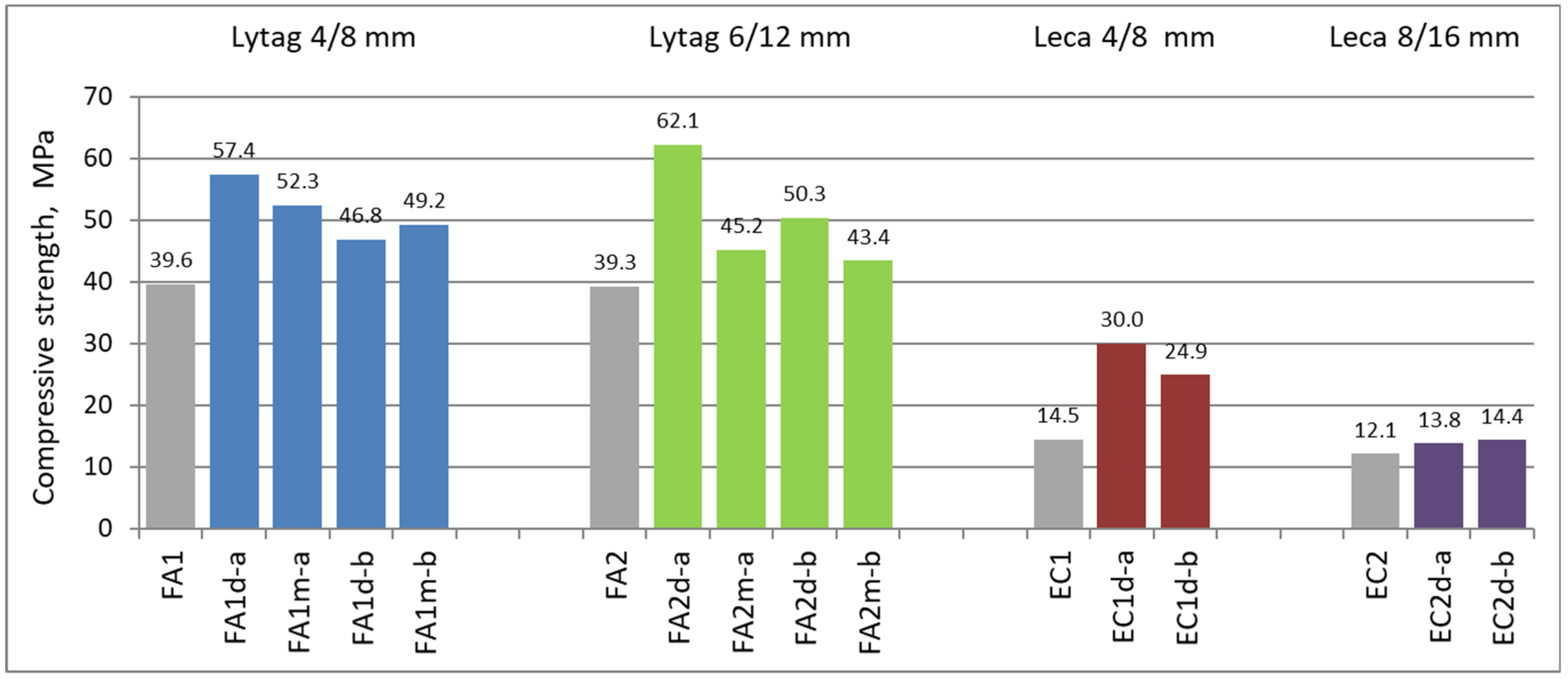

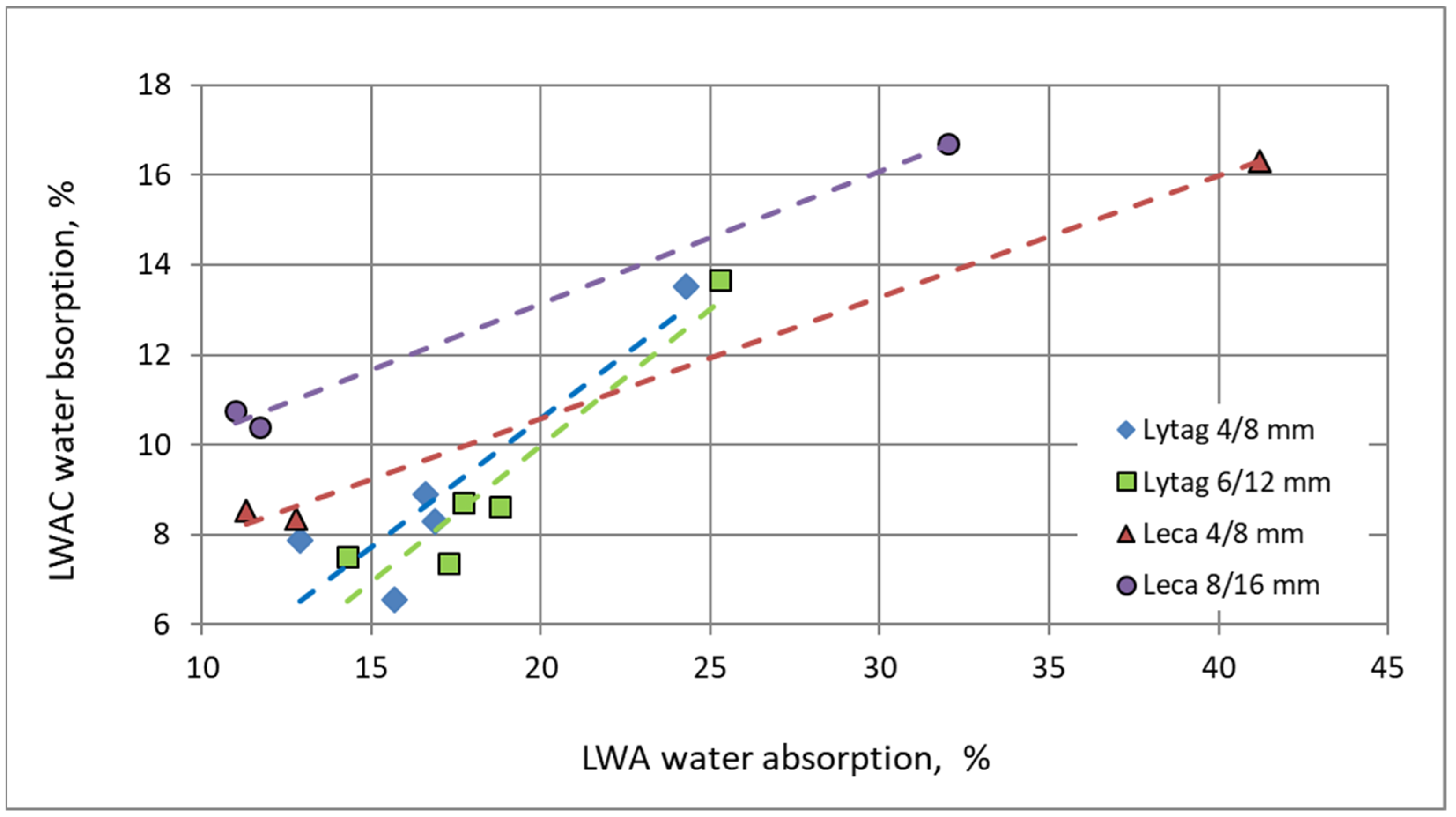
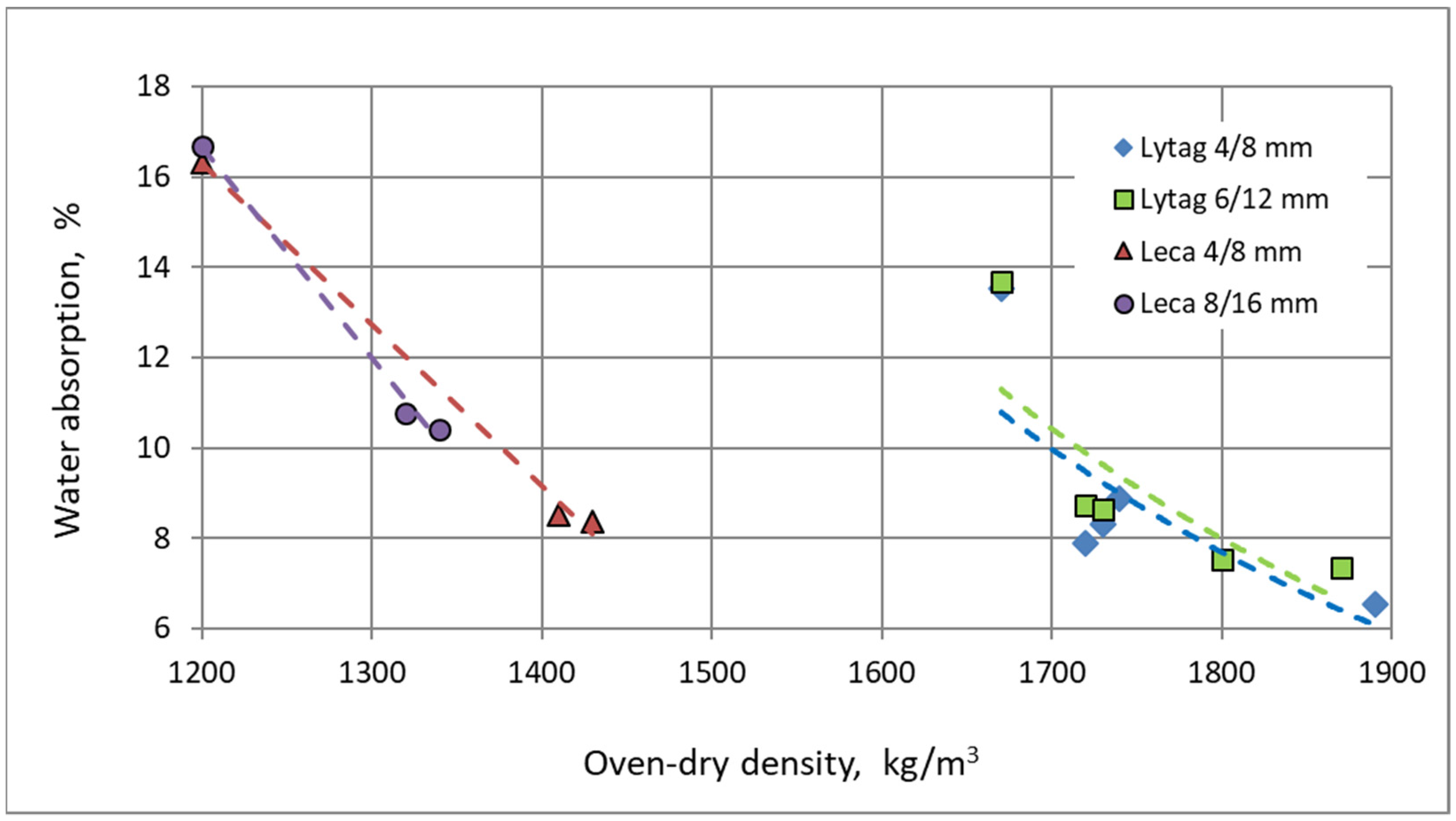

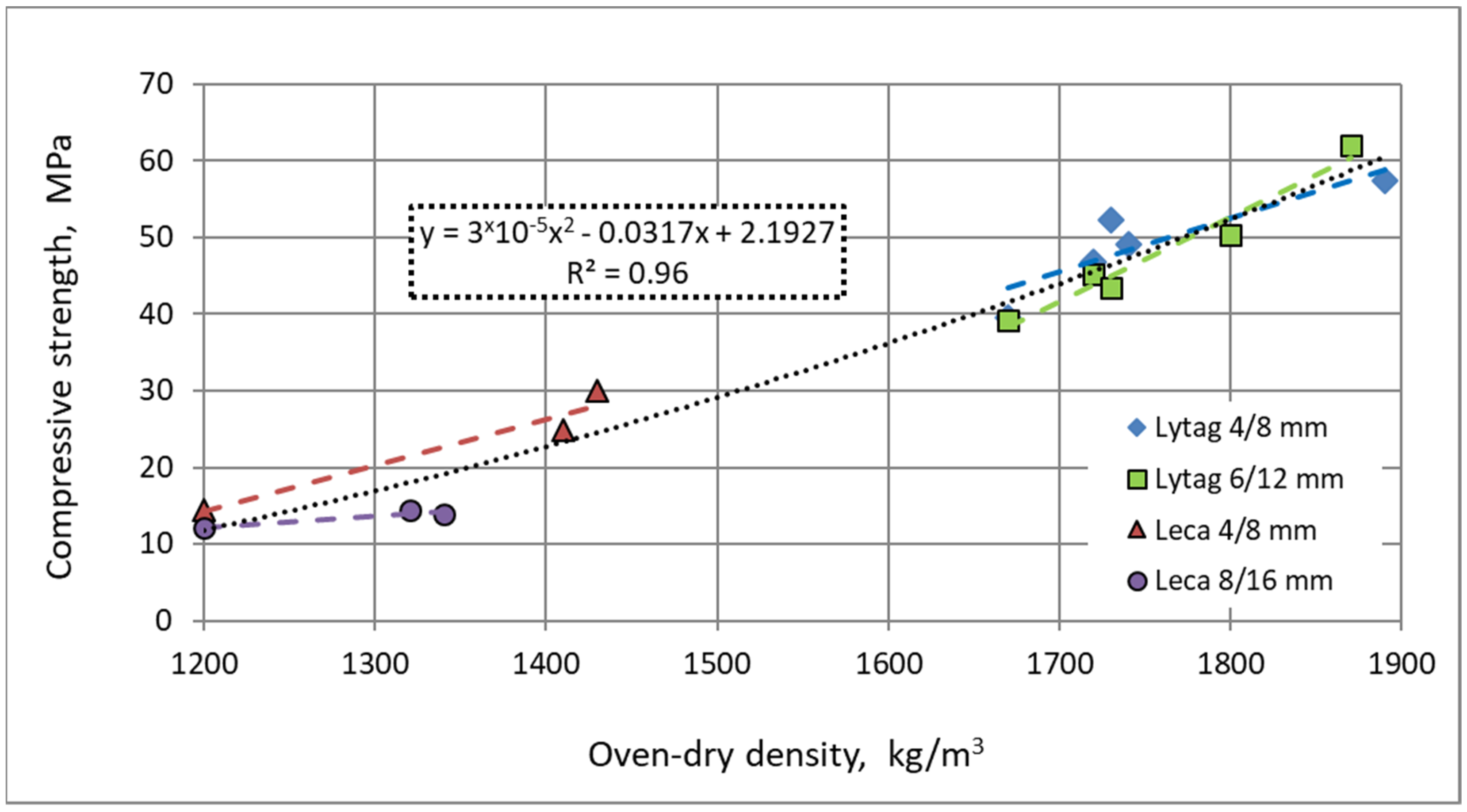


| LWA Designation | LWA Type | Fraction | Cement Paste Used for LWA Impregnation | Initial Moisture Content before Impregnation, % | Particle Density, kg/m3 | Water Absorption after 24 h, % | Max. Water Absorption, % | Crushing Resistance, MPa |
|---|---|---|---|---|---|---|---|---|
| FA1 | Lytag | 4/8 mm | - | - | 1320 | 18.8 | 24.3 | 8.0 |
| FA1d-a | Lytag | 4/8 mm | w/c = 0.55; Sp = 0 | 0 | 1500 | 12.4 | 15.7 | 8.5 |
| FA1m-a | Lytag | 4/8 mm | w/c = 0.55; Sp = 0 | 18.0 | 1400 | 13.7 | 16.9 | 8.5 |
| FA1d-b | Lytag | 4/8 mm | w/c = 0.37; Sp = 1%m.c. | 0 | 1440 | 9.8 | 12.9 | 9.4 |
| FA1m-b | Lytag | 4/8 mm | w/c = 0.37; Sp = 1%m.c. | 18.0 | 1400 | 12.8 | 16.6 | 8.8 |
| FA2 | Lytag | 6/12 mm | - | - | 1340 | 19.3 | 25.3 | 7.2 |
| FA2d-a | Lytag | 6/12 mm | w/c = 0.55; Sp = 0 | 0 | 1510 | 14.2 | 17.3 | 7.6 |
| FA2m-a | Lytag | 6/12 mm | w/c = 0.55; Sp = 0 | 17.0 | 1370 | 14.9 | 17.7 | 7.5 |
| FA2d-b | Lytag | 6/12 mm | w/c = 0.37; Sp = 1%m.c. | 0 | 1420 | 11.7 | 14.3 | 7.9 |
| FA2m-b | Lytag | 6/12 mm | w/c = 0.37; Sp = 1%m.c. | 17.0 | 1360 | 14.2 | 18.8 | 7.6 |
| EC1 | Leca | 4/8 mm | - | - | 550 | 36.4 | 41.2 | 1.4 |
| EC1d-a | Leca | 4/8 mm | w/c = 0.55; Sp = 0 | 0 | 820 | 11.7 | 12.8 | 1.5 |
| EC1d-b | Leca | 4/8 mm | w/c = 0.37; Sp = 1%m.c. | 0 | 840 | 10.2 | 11.3 | 1.4 |
| EC2 | Leca | 8/16 mm | - | - | 560 | 30.7 | 32.0 | 1.2 |
| EC2d-a | Leca | 8/16 mm | w/c = 0.55; Sp = 0 | 0 | 780 | 10.8 | 11.7 | 1.2 |
| EC2d-b | Leca | 8/16 mm | w/c = 0.37; Sp = 1%m.c. | 0 | 770 | 10.2 | 11.0 | 1.1 |
| N° | Mix Designation | LWA, kg/m3 | Water to LWA, kg/m3 | Natural Sand, kg/m3 | Cement, kg/m3 | Water, kg/m3 |
|---|---|---|---|---|---|---|
| 1 | FA1 | 581 | 99 | 512 | 420 | 231 |
| 2 | FA1d-a | 660 | - | 512 | 420 | 231 |
| 3 | FA1m-a | 616 | - | 512 | 420 | 231 |
| 4 | FA1d-b | 634 | - | 512 | 420 | 231 |
| 5 | FA1m-b | 616 | - | 512 | 420 | 231 |
| 6 | FA2 | 590 | 100 | 512 | 420 | 231 |
| 7 | FA2d-a | 664 | - | 512 | 420 | 231 |
| 8 | FA2m-a | 603 | - | 512 | 420 | 231 |
| 9 | FA2d-b | 625 | - | 512 | 420 | 231 |
| 10 | FA2m-b | 598 | - | 512 | 420 | 231 |
| 11 | EC1 | 242 | 82 | 512 | 420 | 231 |
| 12 | EC1d-a | 361 | - | 512 | 420 | 231 |
| 13 | EC1d-b | 370 | - | 512 | 420 | 231 |
| 14 | EC2 | 246 | 66 | 512 | 420 | 231 |
| 15 | EC2d-a | 343 | - | 512 | 420 | 231 |
| 16 | EC2d-b | 339 | - | 512 | 420 | 231 |
Publisher’s Note: MDPI stays neutral with regard to jurisdictional claims in published maps and institutional affiliations. |
© 2021 by the authors. Licensee MDPI, Basel, Switzerland. This article is an open access article distributed under the terms and conditions of the Creative Commons Attribution (CC BY) license (https://creativecommons.org/licenses/by/4.0/).
Share and Cite
Domagała, L.; Podolska, A. Effect of Lightweight Aggregate Impregnation on Selected Concrete Properties. Materials 2022, 15, 198. https://doi.org/10.3390/ma15010198
Domagała L, Podolska A. Effect of Lightweight Aggregate Impregnation on Selected Concrete Properties. Materials. 2022; 15(1):198. https://doi.org/10.3390/ma15010198
Chicago/Turabian StyleDomagała, Lucyna, and Agnieszka Podolska. 2022. "Effect of Lightweight Aggregate Impregnation on Selected Concrete Properties" Materials 15, no. 1: 198. https://doi.org/10.3390/ma15010198
APA StyleDomagała, L., & Podolska, A. (2022). Effect of Lightweight Aggregate Impregnation on Selected Concrete Properties. Materials, 15(1), 198. https://doi.org/10.3390/ma15010198





